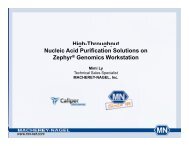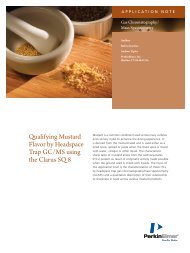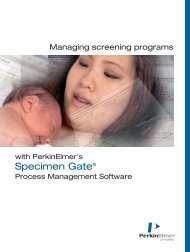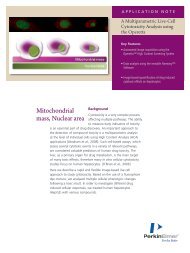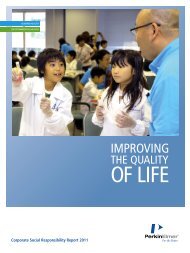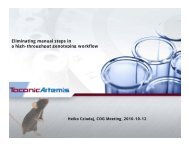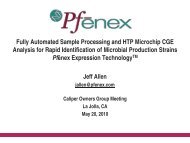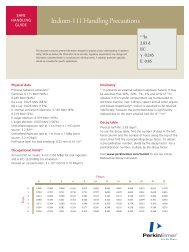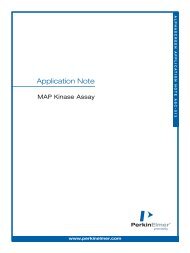Albumin Kit - PerkinElmer
Albumin Kit - PerkinElmer
Albumin Kit - PerkinElmer
Create successful ePaper yourself
Turn your PDF publications into a flip-book with our unique Google optimized e-Paper software.
TECHNICAL<br />
DATA<br />
SHEET<br />
AlphaLISA ® Research Reagents<br />
Caution: For Laboratory Use. A research chemical for research purposes only.<br />
<strong>Albumin</strong> <strong>Kit</strong><br />
Product No.: AL294 C/F<br />
Lot No.: P1<br />
Material Provided<br />
Format: AL294C: 500 assay points AL294F: 5 000 assay points<br />
The number of assay points is based on an assay volume of 50 µL in 96- or 384-well assay plates using the kit<br />
components at the recommended concentrations.<br />
Manufacturing date: January 19, 2011<br />
Product Information<br />
<strong>Kit</strong> content:<br />
Storage:<br />
Stability:<br />
Application:<br />
Sensitivity:<br />
Dynamic range:<br />
The kit contains 5 components: AlphaLISA Acceptor beads coated with an Anti-Analyte<br />
Antibody, Streptavidin-coated Donor beads, Biotinylated Anti-Analyte Antibody, lyophilized<br />
analyte and 5X AlphaLISA NaCl Buffer.<br />
Assay microplates (96-, 384- or 1536-well plates) must be purchased separately (see page 3 for more details).<br />
Store kit in the dark at +4˚C.<br />
This product is stable for at least 12 months from the manufacturing date when stored in its<br />
original packaging and the recommended storage conditions.<br />
This kit is designed for the quantitative determination of human <strong>Albumin</strong> in urine, buffered<br />
solution or cell culture medium using a homogeneous AlphaLISA assay (no wash steps).<br />
Lower Detection Limit (LDL): 105 pg/mL (see page 8: Assay Performance Characteristics).<br />
A unique assay protocol has been developed for this kit (see page 5: Protocol).<br />
105 – 1 000 000 pg/mL (see page 8: Assay Performance Characteristics).<br />
FOR RESEARCH USE ONLY. NOT FOR USE IN DIAGNOSTIC PROCEDURES.<br />
Precautions<br />
Only the AlphaScreen ® Donor beads are light-sensitive. All the other assay reagents can be used under normal light<br />
conditions. All Alpha assays using the Donor beads should be performed under subdued laboratory lighting<br />
(< 100 lux). Green filters (Roscolux filters #389 from Rosco, or the equivalent) can be applied to light fixtures.<br />
All blood components and biological materials should be handled as potentially hazardous. Some analytes are from<br />
human source.<br />
Some analytes are present in saliva. Take precautionary measures to avoid contamination of the reagent solutions.<br />
The Biotinylated Anti-Analyte Antibody contains sodium azide. Contact with skin or inhalation should be avoided.<br />
TDS-AL294-01<br />
Page 1 of 10
Quality Control<br />
The LDL for this lot was verified using the AlphaLISA assay described in this technical data sheet. We certify that these<br />
results meet our quality release criteria.<br />
Reagents and Materials<br />
The reagents provided in the AlphaLISA kit are listed in the table below:<br />
<strong>Kit</strong> components<br />
AL294C<br />
(500 assay points)<br />
AL294F<br />
(5 000 assay points)<br />
AlphaLISA Anti-<strong>Albumin</strong> Acceptor beads<br />
stored in PBS, 0.05% Proclin-300, pH 7.2<br />
50 µL @ 5 mg/mL<br />
(1 brown tube, white cap)<br />
500 µL @ 5 mg/mL<br />
(1 brown tube, white cap)<br />
Streptavidin (SA)-coated Donor beads<br />
stored in 25 mM HEPES, 100 mM NaCl,<br />
0.05% Proclin-300, pH 7.4<br />
200 µL @ 5 mg/mL<br />
(1 brown tube, blue cap)<br />
2 X 1 mL @ 5 mg/mL<br />
(2 brown tubes, blue caps)<br />
Biotinylated Antibody Anti-<strong>Albumin</strong> stored in<br />
PBS, 0.1% Tween-20, 0.05% NaN 3 , pH 7.4<br />
50 µL @ 500 nM<br />
(1 tube, black cap)<br />
500 µL @ 500 nM<br />
(1 tube, black cap)<br />
AlphaLISA human <strong>Albumin</strong><br />
(1 µg), lyophilized analyte *<br />
1 tube, clear cap 1 tube, clear cap<br />
AlphaLISA NaCl Buffer<br />
(5X) **<br />
10 mL, 2 small bottles 100 mL, 2 large bottles<br />
* Reconstitute human <strong>Albumin</strong> in 100 µL Milli-Q ® grade H 2 O. The reconstituted analyte should be used within 60<br />
minutes, if possible, or aliquoted into screw-capped polypropylene vials and stored at -20 C for further experiments.<br />
Avoid multiple freeze-thaw cycles. It has been demonstrated that reconstituted human <strong>Albumin</strong> is stable for at least<br />
75 days at -20°C. One vial contains an amount of human <strong>Albumin</strong> sufficient for performing 10 standard curves.<br />
Additional vials can be ordered separately (cat # AL294S).<br />
** Contains 125 mM HEPES, pH 7.4, 2.5 M NaCl, 5 mg/mL Dextran-500, 2.5% Triton X-100, 0.25% Proclin-300,<br />
2.5% gelatin. Extra buffer can be ordered separately (cat # AL007C: 10 mL, cat # AL007F: 100 mL).<br />
Note: 5X buffer might be slightly yellow. However, this does not affect the assay results.<br />
Once diluted, 1X AlphaLISA NaCl Buffer contains 25 mM HEPES, pH 7.4, 0.5 M NaCl, 1 mg/mL Dextran-500,<br />
0.5% Triton X-100, 0.05% Proclin-300 and 0.5% gelatin.<br />
Sodium azide should not be added to the stock reagents. High concentrations of sodium azide (> 0.001 % final in the<br />
assay) might decrease the AlphaLISA signal. Note that sodium azide from the Biotinylated Antibody stock solution will not<br />
interfere with the AlphaLISA signal (0.0001% final in the assay).<br />
TDS-AL294-01<br />
Page 2 of 10
Specific additional required reagents and materials:<br />
The following materials are recommended:<br />
Item Suggested source Catalog #<br />
TopSeal-A Adhesive<br />
Sealing Film<br />
EnSpire ® or EnVision ®<br />
Multilabel Alpha Reader<br />
<strong>PerkinElmer</strong> Inc. 6005185<br />
<strong>PerkinElmer</strong> Inc. -<br />
Protocols have been optimized for 50 µL assays in white OptiPlate-384 microplates. Other assay volumes can be used<br />
with similar protocols and identical final AlphaLISA reagent concentrations:<br />
Format<br />
# of data<br />
points<br />
Total<br />
assay<br />
volume<br />
Sample<br />
volume<br />
AlphaLISA<br />
beads / Biotin<br />
Antibody MIX<br />
volume<br />
SA-Donor<br />
beads<br />
volume<br />
Plate recommendation<br />
250 100 µL 10 µL 10 µL 80 µL White OptiPlate-96 (cat # 6005290)<br />
AL294C<br />
500 50 µL 5 µL 5 µL 40 µL<br />
1 250 20 µL 2 µL 2 µL 16 µL<br />
White ½ AreaPlate-96 (cat # 6005560)<br />
White OptiPlate-384 (cat # 6007290)<br />
Light gray AlphaPlate-384 (cat # 6005350)<br />
Light gray AlphaPlate-384 (cat # 6005350)<br />
ProxiPlate-384 Plus (cat # 6008280)<br />
White OptiPlate-384 (cat # 6007290)<br />
2 500 10 µL 1 µL 1 µL 8 µL Light gray AlphaPlate-1536 (cat # 6004350)<br />
AL294F<br />
5 000 50 µL 5 µL 5 µL 40 µL<br />
12 500 20 µL 2 µL 2 µL 16 µL<br />
White ½ AreaPlate-96 (cat # 6005560)<br />
White OptiPlate-384 (cat # 6007290)<br />
Light gray AlphaPlate-384 (cat # 6005350)<br />
Light gray AlphaPlate-384 (cat # 6005350)<br />
ProxiPlate-384 Plus (cat # 6008280)<br />
White OptiPlate-384 (cat # 6007290)<br />
25 000 10 µL 1 µL 1 µL 8 µL Light gray AlphaPlate-1536 (cat # 6004350)<br />
TDS-AL294-01<br />
Page 3 of 10
Analyte of Interest<br />
Human serum albumin (HSA) is a 66 kDa protein produced by the liver. HSA constitutes two thirds of the protein mass of<br />
serum and plays a key role in the transport of small molecules in the blood such as fatty acids, vitamins, hormones,<br />
divalent cations, and drugs. Another important function of HSA is to maintain osmotic pressure and pH in the blood. HSA<br />
is an important biomarker in kidney disease. In albuminuria, albumin is not reabsorbed properly by kidney glomeruli and is<br />
excreted in the urine. Generally, in hypoalbuminemia, a lower level of albumin in serum can be explained by a kidney<br />
disease, poor liver function, or inflammation.<br />
Description of the AlphaLISA Assay<br />
AlphaLISA technology allows the detection of molecules of interest in buffer, cell culture media, serum and plasma in a<br />
highly sensitive, quantitative, reproducible and user-friendly mode. In an AlphaLISA assay, a Biotinylated Anti-Analyte<br />
Antibody binds to the Streptavidin-coated Donor beads while another Anti-Analyte Antibody is conjugated to AlphaLISA<br />
Acceptor beads. In the presence of the analyte, the beads come into close proximity. The excitation of the Donor beads<br />
provokes the release of singlet oxygen molecules that triggers a cascade of energy transfer in the Acceptor beads,<br />
resulting in a sharp peak of light emission at 615 nm (see figure below).<br />
TDS-AL294-01<br />
Page 4 of 10
Recommendations<br />
General recommendations:<br />
The volume indicated on each tube is guaranteed for single pipetting. Multiple pipetting of the reagents may reduce<br />
the theoretical amount left in the tube. To minimize loss when pipetting beads, it is preferable not to prewet the tip.<br />
Centrifuge all tubes (including lyophilized analyte) before use to improve recovery of content (2 000 g, 10-15 sec).<br />
Resuspend all reagents by vortexing before use.<br />
Use Milli-Q ® grade H 2 O (18 MΩ•cm) to dilute 5X AlphaLISA NaCl Buffer and to reconstitute the lyophilized analyte.<br />
When diluting the standard or samples, change tips between each standard or sample dilution. When loading<br />
reagents in the assay microplate, change tips between each standard or sample addition and after each set of<br />
reagents.<br />
When reagents are added in the microplate, make sure the liquids are at the bottom of the well.<br />
Small volumes may be prone to evaporation. It is recommended to cover microplates with TopSeal-A Adhesive<br />
Sealing Films to reduce evaporation during incubation. Microplates can be read with the TopSeal-A Film.<br />
The AlphaLISA signal is detected with an EnVision Multilabel Reader equipped with the ALPHA option using the<br />
AlphaScreen standard settings (e.g. Total Measurement Time: 550 ms, Laser 680 nm Excitation Time: 180 ms,<br />
Mirror: D640as, Emission Filter: M570w, Center Wavelength 570 nm, Bandwidth 100 nm, Transmittance 75%).<br />
AlphaLISA signal will vary with temperature and incubation time. For consistent results, identical incubation times<br />
and temperature should be used for each plate.<br />
The standard curves shown in this technical data sheet are provided for information only. A standard curve must be<br />
generated for each experiment. The standard curve should be performed in a similar matrix as the samples (e.g.<br />
FBS for serum samples).<br />
Specific recommendations:<br />
AlphaLISA assays can be performed in cell culture medium with or without phenol red, with the following<br />
recommendations: if possible, avoid biotin-containing medium (e.g. RPMI medium) as lower counts and lower<br />
sensitivity are expected. Add at least 1% FBS or 0.1% BSA to cell culture medium.<br />
When analyzing urine samples, perform the standard curve in 1X AlphaLISA NaCl Buffer and dilute the samples at<br />
least 1 000-fold with 1X AlphaLISA NaCl Buffer before testing to fall within the assay dynamic range.<br />
We highly recommend wearing gloves, mask, and use plugged tips to avoid contamination.<br />
Protocol<br />
High sensitivity protocol (2 incubation steps) – Dilution of standards in 1X AlphaLISA NaCl Buffer or cell culture<br />
medium<br />
The protocol described below is an example for generating one standard curve in a 50 µL final assay volume (48 wells,<br />
triplicate determinations). The protocol also includes testing samples in 452 wells. If a different amount of samples are<br />
tested, the volumes of all reagents have to be adjusted accordingly. These calculations do not include excess reagent to<br />
account for losses during transfer of solutions or dead volumes.<br />
The standard dilution protocol is provided for information only. As needed, the number of replicates or the range of<br />
concentrations covered can be modified.<br />
Use of four background points in triplicate (12 wells) is recommended when LDL is calculated. One background point in<br />
triplicate (3 wells) can be used when LDL is not calculated.<br />
TDS-AL294-01<br />
Page 5 of 10
IMPORTANT: PLEASE READ THE RECOMMENDATIONS ABOVE BEFORE USE<br />
Steps for Preparing Reagents<br />
The protocol described below is for one standard curve (48 wells) and samples (452 wells). Dilution of standards<br />
can be done in 1X AlphaLISA NaCl Buffer or cell culture medium.<br />
If a different amount of samples are tested, the volumes of all reagents have to be adjusted accordingly.<br />
1) Preparation of 1X AlphaLISA NaCl Buffer:<br />
Add 5.0 mL of 5X AlphaLISA NaCl Buffer to 20.0 mL H 2 O.<br />
2) Preparation of human <strong>Albumin</strong> analyte standard dilutions:<br />
Reconstitute lyophilized human <strong>Albumin</strong> (1 µg) in 100 µL H 2 O.<br />
Prepare standard dilutions as follows (change tip between each standard dilution):<br />
Tube<br />
Vol. of<br />
human <strong>Albumin</strong> (µL)<br />
Vol. of<br />
diluent (µL) *<br />
[human <strong>Albumin</strong>]<br />
in standard curve<br />
(g/mL in 5 µL) (pg/mL in 5 µL)<br />
A<br />
10 µL of reconstituted<br />
human <strong>Albumin</strong><br />
90 1E-06 1 000 000<br />
B 60 µL of tube A 140 3E-07 300 000<br />
C 60 µL of tube B 120 1E-07 100 000<br />
D 60 µL of tube C 140 3E-08 30 000<br />
E 60 µL of tube D 120 1E-08 10 000<br />
F 60 µL of tube E 140 3E-09 3 000<br />
G 60 µL of tube F 120 1E-09 1 000<br />
H 60 µL of tube G 140 3E-10 300<br />
I 60 µL of tube H 120 1E-10 100<br />
J 60 µL of tube I 140 3E-11 30<br />
K 60 µL of tube J 120 1E-11 10<br />
L 60 µL of tube K 140 3E-12 3<br />
M ** (background) 0 100 0 0<br />
N ** (background) 0 100 0 0<br />
O ** (background) 0 100 0 0<br />
P ** (background) 0 100 0 0<br />
* Dilute standards in diluent (e.g. 1X AlphaLISA NaCl Buffer or cell culture medium).<br />
At low concentrations of analyte, a significant amount of analyte can bind to the vial. Therefore, load the analyte<br />
standard dilutions in the assay microplate within 60 minutes of preparation.<br />
** Four background points in triplicate (12 wells) are used when LDL is calculated. If LDL does not need to be<br />
calculated, one background point in triplicate can be used (3 wells).<br />
3) Preparation of 5X AlphaLISA Anti-<strong>Albumin</strong> Acceptor beads + Biotinylated Antibody Anti-<strong>Albumin</strong> MIX<br />
(100 µg/mL / 10 nM):<br />
Add 50 µL of 5 mg/mL AlphaLISA Anti-<strong>Albumin</strong> Acceptor beads and 50 µL of 500 nM Biotinylated Antibody Anti-<br />
<strong>Albumin</strong> to 2 400 µL of 1X AlphaLISA NaCl Buffer. Prepare just before use.<br />
4) Preparation of 1.25X Streptavidin (SA) Donor beads (50 µg/mL): Keep the beads under subdued laboratory lighting.<br />
Add 200 µL of 5 mg/mL SA-Donor beads to 19 800 µL of 1X AlphaLISA NaCl Buffer.<br />
5) Samples: If applicable, dilute samples to be tested in diluent (e.g. 1X AlphaLISA NaCl Buffer or cell culture medium).<br />
TDS-AL294-01<br />
Page 6 of 10
AlphaLISA Signal (counts)<br />
AlphaLISA Signal (counts)<br />
6) In a 96- or 384-well microplate:<br />
Add 5 µL of each analyte standard dilution or 5 µL of sample<br />
Add 5 µL of a 10X MIX (freshly prepared)<br />
AlphaLISA Anti-Analyte Acceptor beads (10 µg/mL final) and Biotinylated Antibody Anti-Analyte (1 nM final)<br />
Incubate 60 minutes at 23˚C<br />
Add 40 µL of 1.25X SA-Donor beads (40 µg/mL final)<br />
Incubate 30 minutes at 23˚C in the dark<br />
Read using EnSpire or EnVision-Alpha Reader<br />
Typical results in 1X AlphaLISA NaCl Buffer<br />
Log-Log scale:<br />
Linear-Linear scale (linear range):<br />
1,000,000<br />
100,000<br />
LDL : 110 pg/mL<br />
40,000<br />
30,000<br />
r 2 = 0.9981<br />
10,000<br />
20,000<br />
1,000<br />
10,000<br />
100<br />
0<br />
- -12 -11 -10 -9 -8 -7 -6<br />
Log [human <strong>Albumin</strong>] (g/mL)<br />
[human <strong>Albumin</strong>] (pg/mL)<br />
The data was generated using a white Optiplate-384 microplate and an EnVision-Alpha Reader 2102.<br />
0<br />
10,000<br />
20,000<br />
30,000<br />
40,000<br />
Interpreting the Data<br />
Calculate the average count value for the background wells.<br />
Generate a standard curve by plotting the AlphaLISA counts versus the concentration of analyte. A log scale can be<br />
used for either or both axes. No additional data transformation is required.<br />
Analyze data according to a nonlinear regression using the 4-parameter logistic equation (sigmoidal dose-response<br />
curve with variable slope) and a 1/Y 2 data weighting (the values at maximal concentrations of analyte after the hook<br />
point should be removed for correct analysis).<br />
The LDL is calculated by interpolating the average background counts (12 wells without analyte) + 3 x standard<br />
deviation value (average background counts + (3xSD)) on the standard curve.<br />
Read from the standard curve the concentration of analyte contained in the samples.<br />
If samples have been diluted, the concentration read from the standard curve must be multiplied by the dilution<br />
factor.<br />
TDS-AL294-01<br />
Page 7 of 10
Assay Performance Characteristics<br />
Sensitivity:<br />
The LDL was calculated as described above. This value corresponds to the lowest concentration of analyte that can be<br />
detected in a volume of 5 µL using the recommended assay conditions.<br />
Average LDL is 105 pg/mL * (using 5 µL of analyte in AlphaLISA NaCl Buffer) (mean of 18 independent<br />
experiments).<br />
* Note that LDL can be decreased (i.e. sensitivity increased) by increasing the volume of analyte in the assay (e.g. use<br />
10 µL of analyte in a final assay volume of 50 µL).<br />
Dynamic range: 105 – 1 000 000 pg/mL (in AlphaLISA NaCl Buffer)<br />
Assay precision:<br />
The following assay precision data were calculated from a total of 18 assays. Two operators performed three independent<br />
assays using three different kit lots. Each assay consisted of one standard curve and three control samples of high (A),<br />
medium (B) and low (C) concentration, assayed in triplicate. The assays were performed in 384-well format using<br />
AlphaLISA NaCl Buffer.<br />
Intra-assay precision:<br />
The intra-assay precision was determined using a total of 18 independent determinations in triplicate for each control<br />
sample.<br />
Sample<br />
Mean SD % CV<br />
(pg/mL) (pg/mL) (n = 18)<br />
A 34 310 2 144 6.2<br />
B 10 358 533 5.1<br />
C 1 117 123 11.0<br />
TDS-AL294-01<br />
Page 8 of 10
Inter-assay precision:<br />
The inter-assay precision was determined using a total of 6 independent determinations with 9 measurements for each<br />
control sample.<br />
Sample<br />
Mean SD % CV<br />
(pg/mL) (pg/mL) (n = 6)<br />
A 34 310 4 498 13.1<br />
B 10 358 1 068 10.3<br />
C 1 117 151 13.5<br />
Human serum experiments:<br />
In the following experiments, AlphaLISA NaCl Buffer was used as diluent in both the standard curve and dilution of<br />
samples. Additionally, all human urine samples tested were pre-diluted 1 000-fold with the diluent before being<br />
processed.<br />
Dilutional linearity:<br />
The dilutional linearity was determined by serial dilutions of a pool of human urine. The recovery was calculated using the<br />
1 000-fold diluted sample as the 100% value. The average recovery from two independent measurements is reported.<br />
Dilution<br />
Factor<br />
% Recovery<br />
1 000 100<br />
2 000 107<br />
4 000 119<br />
8 000 107<br />
16 000 107<br />
Urine sample values:<br />
Frozen human urine samples were analyzed using the above stated conditions.<br />
Number of samples 18<br />
Number of samples with analyte concentration ≥ LDL 18<br />
Average analyte concentration<br />
11 µg/mL<br />
Range of analyte concentration<br />
1.4 - 38 µg/mL<br />
TDS-AL294-01<br />
Page 9 of 10
Specificity:<br />
Cross-reactivity of the AlphaLISA <strong>Albumin</strong> <strong>Kit</strong> was tested using the following proteins at 0.1 µg/mL in AlphaLISA NaCl<br />
Buffer, except for Alpha-fetoprotein tested at 1.0 µg/mL.<br />
Protein % Cross-reactivity LDL (pg/mL)<br />
Mouse <strong>Albumin</strong> 0 -<br />
Rat <strong>Albumin</strong> 0 -<br />
Bovine <strong>Albumin</strong> 0 -<br />
Alpha-fetoprotein 23 694<br />
This product is not for resale or distribution except by authorized distributors.<br />
LIMITED WARRANTY: <strong>PerkinElmer</strong> BioSignal Inc. warrants that, at the time of shipment, the products sold by it are free from defects in material and workmanship and<br />
conform to specifications which accompany the product. <strong>PerkinElmer</strong> BioSignal Inc. makes no other warranty, express or implied with respect to the products, including any<br />
warranty of merchantability or fitness for any particular purpose. Notification of any breach of warranty must be made within 60 days of receipt unless otherwise provided in<br />
writing by <strong>PerkinElmer</strong> BioSignal Inc. No claim shall be honored if the customer fails to notify <strong>PerkinElmer</strong> BioSignal Inc. within the period specified. The sole and exclusive<br />
remedy of the customer for any liability of <strong>PerkinElmer</strong> BioSignal Inc. of any kind including liability based upon warranty (express or implied whether contained herein or<br />
elsewhere), strict liability contract or otherwise is limited to the replacement of the goods or the refunds of the invoice price of goods. <strong>PerkinElmer</strong> BioSignal Inc. shall not in<br />
any case be liable for special, incidental or consequential damages of any kind.<br />
<strong>PerkinElmer</strong>, Inc.<br />
940 Winter Street<br />
Waltham, MA 02451 USA<br />
P: (800) 762-4000 or<br />
(+1) 203-925-4602<br />
www.perkinelmer.com<br />
For a complete listing of our global offices, visit www.perkinelmer.com/ContactUs<br />
Copyright ©2009, <strong>PerkinElmer</strong>, Inc. All rights reserved. <strong>PerkinElmer</strong> ® is a registered trademark of <strong>PerkinElmer</strong>, Inc. All other trademarks are the property of their respective owners.



